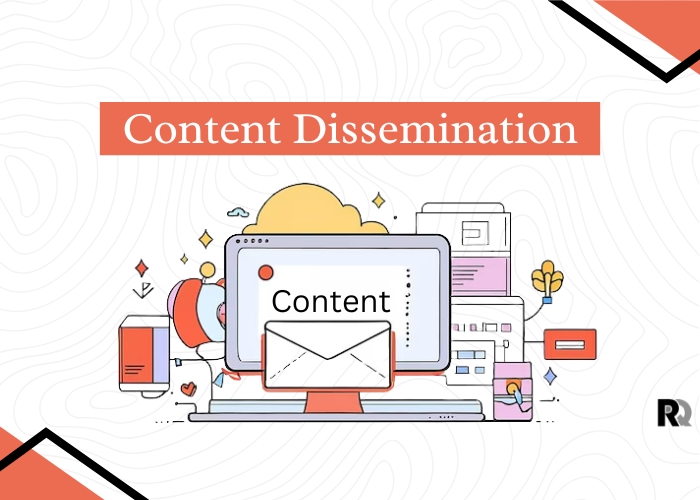In today’s fast-paced digital world, having great content is just one part of the equation. Getting that content in front of the right audience is equally, if not more, important. That’s where content dissemination comes in. It’s a key component of a successful digital marketing strategy, enabling brands to reach their target audience, build awareness, and ultimately, drive sales.
In this blog, we’ll dive into content dissemination techniques, explain why they matter, and show you how to use them to boost your business.
What is Content Dissemination?

At its core, content dissemination is the process of distributing your content across various platforms to reach as many people as possible. Whether through social media, email campaigns, newsletters, or other methods, the aim is simple: get your content in front of the right audience.
Why does it matter? Because creating quality content isn’t enough. If your audience doesn’t see it, it can’t serve its purpose. The more effectively you can disseminate your content, the better chance you have of generating leads, building brand awareness, and increasing conversions.
Content Dissemination vs. Content Distribution: What’s the Difference?
When discussing how to spread your content effectively, you might come across two terms that seem interchangeable: content dissemination and content distribution. While they’re closely related, there’s a subtle difference between the two that can impact how you approach your content strategy.
Content Distribution is primarily about the channels you use to deliver your content. It’s the “what” and “where” of content marketing—deciding which platforms or mediums (social media, email, blogs, etc.) will help you reach your target audience. It’s a more mechanical process focused on getting your content in front of as many eyeballs as possible.
On the other hand, content dissemination goes deeper. It’s the strategic, intentional spread of information tailored to engage a specific audience at the right time. Dissemination isn’t just about distributing content; it’s about ensuring that your content reaches the right people in a way that resonates with them. It involves selecting not only the right platforms but also the right message, timing, and format to generate meaningful engagement.
In simpler terms:
- Content Distribution = Where and how content is shared.
- Content Dissemination = The strategy behind reaching and engaging the right audience with that content.
Both play essential roles in marketing, but to disseminate your content effectively, you need a plan that aligns your message with the audience’s needs, while distribution is the toolset to execute that plan.
By focusing on a solid dissemination strategy, you’ll make sure your content isn’t just seen—it’s understood, appreciated, and acted upon.
Top 3 Popular Methods of Content Dissemination
Now that we understand the importance of content dissemination, let’s take a look at three of the most popular methods to disseminate your content.
1. Generating Traffic Through Social Selling

Social selling is all about using platforms like Facebook, LinkedIn, and Instagram to connect with your audience. But it’s more than just throwing up a post and hoping people will bite. It’s about building relationships, engaging with your followers, and presenting your brand as the solution to their problems.
Why is social selling effective? Because most people are already using social media to research products and services. Infact, 81% of Instagram users look into brands they see on the platform. On YouTube, 70% of users have made a purchase after watching branded content. This makes social selling one of the most powerful ways to disseminate your content and attract new leads.
If your business is active on social media, you’re already practicing some form of social selling. But to get the most out of it, you need to go deeper. Engage authentically with your audience, respond to comments, and provide useful information that aligns with their needs.
2. Increasing Leads Through Email Drip Campaigns

Did you know that 79% of B2B marketers rate email as their most successful channel for distributing content? With an email drip campaign, you send a series of pre-written emails automatically based on a user’s actions. This lets you nurture leads without manually sending emails every time.
Let’s break it down with some examples of drip campaigns:
- Onboarding Campaign: When a new lead provides their email (like downloading a whitepaper), welcome them with emails packed with useful information.
- Retargeting Campaign: This targets leads who’ve engaged with your content but haven’t taken the next step. Drip emails are a great way to draw them back in by offering new, relevant content.
- Post-Demo Campaign: In industries like tech, you may offer product demos to prospects. Use drip emails to reinforce your product’s value and nudge them toward a purchase.
Email drip campaigns are a great method to disseminate real-time content, keeping your audience engaged and informed. Whether it’s to provide updates or encourage demos, a well-crafted drip campaign can increase your conversions significantly.
3. Boosting Customer Engagement Through Newsletters

Newsletter marketing helps you stay top of mind with your existing audience while offering valuable content that reinforces your brand. Subscribers to your newsletter are already warm leads—people interested in what you have to say and sell.
Infact, 81% of B2B marketers say newsletters are their most-used content marketing tool. A well-designed newsletter can drive repeat traffic to your website, offer promotions, and even showcase new products or services. The key is to make your content engaging and exclusive. Give your subscribers a reason to stick around and share your content with others.
Using newsletters as a content dissemination technique allows you to grow your audience while also deepening relationships with existing customers.
More Methods to Disseminate Your Content
While social media, email, and newsletters are some of the most popular, there are many other ways to disseminate your content. Let’s explore a few more:
1. Publishing Content on Your Website or Blog
Your website or blog is your home base for all content. The more content you have here, the more chances you have to attract new visitors. But it’s not enough to just post. Creating engaging videos using tools like a video background remover can help your content stand out and increase shareability across platforms.
You also need to actively promote your content through other channels like social media and email to drive traffic.
2. Publishing an Electronic Newsletter (E-zine)
Publishing an e-zine is an excellent way to share content regularly. It’s one of the oldest and still highly effective ways to distribute your content. Using services like MailChimp or Aweber makes managing your email list and sending out newsletters easy.
3. Utilizing RSS Feeds
RSS feeds allow subscribers to automatically receive your latest blog posts or updates. It’s a simple but effective way to ensure your audience never misses your latest content.
4. Writing for Other Blogs
Guest blogging on relevant sites can help you reach new audiences and position yourself as an expert in your industry. It also provides valuable backlinks to your site, improving your SEO.
5. Submitting Slides and PDFs
Platforms like SlideShare and Scribd allow you to share presentations or PDFs of your content. It’s an easy way to condense information into bite-sized, engaging pieces.
6. Publishing White Papers
White papers are in-depth, research-driven pieces of content that provide value to readers. These are particularly effective in industries like tech and finance, where buyers are looking for well-researched solutions.
7. Attending Meetups and Workshops
While it may not seem like a direct content dissemination technique, networking at meetups and workshops can get more eyes on your content. Building relationships within your industry can lead to shares, mentions, and backlinks to your content.
What to Keep in Mind When Disseminating Your Content?
When planning to disseminate your content, there are several factors you need to consider. These will ensure your efforts are effective and bring you closer to your business goals:
- High-Quality Content: Your content must be accurate, informative, and engaging. Poorly written or unhelpful content can damage your brand’s reputation. If it doesn’t resonate with your audience, they won’t engage, and you’ll miss out on potential leads.
- Targeted Audience: The success of any content dissemination technique lies in targeting the right audience. Focus on the people who will benefit from your content. Carefully segment your audience and tailor your content accordingly.
- Choosing the Right Platforms: It’s crucial to select the best platforms for your brand. Social media, email marketing, blogs, and newsletters all serve different purposes. Choose the platform that aligns with your business goals and target audience.
- Relevant Content: Stay on-topic and relevant. Your content should address current trends, challenges, or common questions within your industry. Outdated or irrelevant content can turn people away.
- Fresh Content: Keep your content updated and relevant. Regularly refresh your material to keep your audience engaged and interested.
- Monitor Your Results: Pay attention to your analytics. If something isn’t working, adjust your strategy. This is the only way to make sure your content dissemination efforts are effective.
Conclusion
Content dissemination is more than just hitting “publish” and hoping for the best. It’s a strategic process that requires planning, execution, and consistent monitoring. By leveraging the methods we’ve discussed—from social selling to newsletters to white papers—you can make sure your content reaches the right people and generates the results you’re looking for.
At Reliqus Consulting, we specialize in helping businesses create and implement effective content dissemination techniques that lead to growth. Contact us today to learn how we can help you distribute your content and drive more leads!

